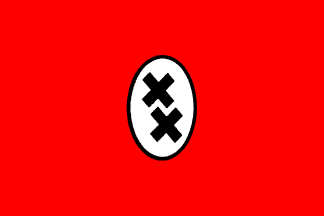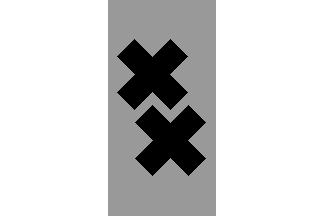Regarding the color of the flag, there was a short thread on the list
back in March, The consensus was that the actual color
used in the production was not meant to suggest that was the intended
color of this fictional flag. The feature film itself was shot in
black & white, and any color of similar intensity would do. As Al has
pointed out, where the studio did display color for public
consumption- e.g. promotional posters- the flag had a red field.
Ned Smith, 16 may 2003
Tomania
I watched "the Great Dictator" (which is a good movie, by the way, in
case you haven't seen it) and noticed, that as the barber is being
driven by the Tomanian military in their invasion near the end of the
movie, there are a lot of flags and banners along one street, with
the Tomanian insignia, the double cross. Being a black and white
picture, I can't be exactly sure what the colors are, but from what I
can tell, it would be black and white, and shows a pair of crosses
together in the center of the flag, in a diagonal arrangement. The
arm band and banner insignias are different, resembling the Nazi arm
bands more closely, with the double cross symbol in a white oval.
Mac Rosevelt, 3 october 2002
I've found a poster showing Chaplin in front of the flag. The double cross emblem appears on Chaplin's hat in the poster even as he obscures it on the flag. But it is a clear parody of
the Nazi flag, with a red background and a black double cross on a white ellipse (major
axis vertical.)
Albert Kirsch, 10 october 2002
In a programme about Chaplin's "The Great Dictator" there is colour footage made from the set of the movie that shows some flags. The armbinds were skyblue with the emblem white crosses on a black oval. There were also yellow flags with the two black crosses, and vertical banners that appeared to be black, white & grey, like António's image on FOTW.
The cover/poster of the movie shows a red flag, and a red armband on Chaplin. The grey and skyblue was probably chosen because they "appear" as red in black & white.
Jostein Nygård, 3 march 2003
Tomania's Vertical Banner
Some footage of the movie shows also vertical hanging flags, with the emblem in inverted colors (white crosses on white-rimmed black ovals) on a medium background. It seems too light to be red, even if it would be so to go along with the national flag (documented red in color promo material, as Al shown), but I didn't want to risk and colored it grey instead.António Martins-Tuválkin, 11 october 2002
Tomania's marching soldiers flag
Something for yet another tomanian flag, held by parading soldiers. It shows hanging windless, so I had to guess a bit.António Martins-Tuválkin, 11 october 2002



